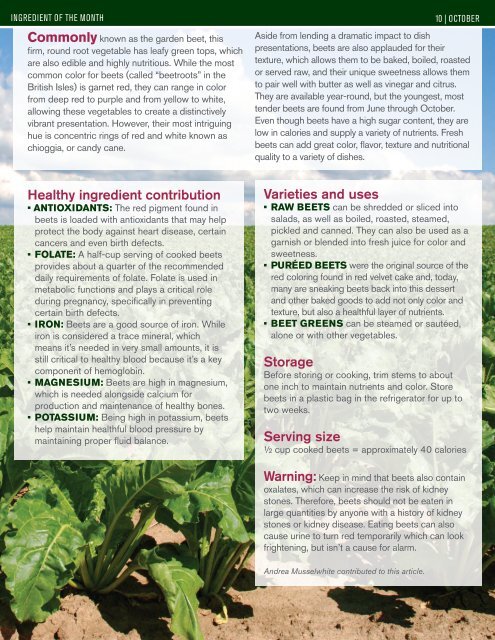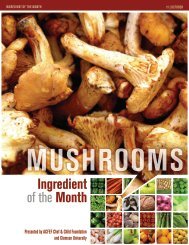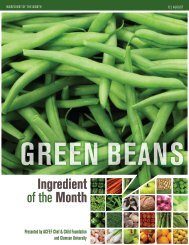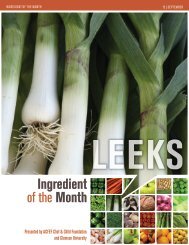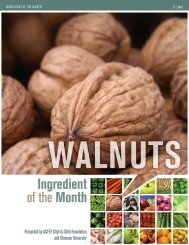Beets - Clemson University
Beets - Clemson University
Beets - Clemson University
- No tags were found...
You also want an ePaper? Increase the reach of your titles
YUMPU automatically turns print PDFs into web optimized ePapers that Google loves.
Ingredient of the MonthCommonly known as the garden beet, thisfirm, round root vegetable has leafy green tops, whichare also edible and highly nutritious. While the mostcommon color for beets (called “beetroots” in theBritish Isles) is garnet red, they can range in colorfrom deep red to purple and from yellow to white,allowing these vegetables to create a distinctivelyvibrant presentation. However, their most intriguinghue is concentric rings of red and white known aschioggia, or candy cane.10 | octoberAside from lending a dramatic impact to dishpresentations, beets are also applauded for theirtexture, which allows them to be baked, boiled, roastedor served raw, and their unique sweetness allows themto pair well with butter as well as vinegar and citrus.They are available year-round, but the youngest, mosttender beets are found from June through October.Even though beets have a high sugar content, they arelow in calories and supply a variety of nutrients. Freshbeets can add great color, flavor, texture and nutritionalquality to a variety of dishes.Healthy ingredient contribution• Antioxidants: The red pigment found inbeets is loaded with antioxidants that may helpprotect the body against heart disease, certaincancers and even birth defects.• Folate: A half-cup serving of cooked beetsprovides about a quarter of the recommendeddaily requirements of folate. Folate is used inmetabolic functions and plays a critical roleduring pregnancy, specifically in preventingcertain birth defects.• Iron: <strong>Beets</strong> are a good source of iron. Whileiron is considered a trace mineral, whichmeans it’s needed in very small amounts, it isstill critical to healthy blood because it’s a keycomponent of hemoglobin.• Magnesium: <strong>Beets</strong> are high in magnesium,which is needed alongside calcium forproduction and maintenance of healthy bones.• Potassium: Being high in potassium, beetshelp maintain healthful blood pressure bymaintaining proper fluid balance.Varieties and uses• Raw beets can be shredded or sliced intosalads, as well as boiled, roasted, steamed,pickled and canned. They can also be used as agarnish or blended into fresh juice for color andsweetness.• Puréed beets were the original source of thered coloring found in red velvet cake and, today,many are sneaking beets back into this dessertand other baked goods to add not only color andtexture, but also a healthful layer of nutrients.• Beet greens can be steamed or sautéed,alone or with other vegetables.StorageBefore storing or cooking, trim stems to aboutone inch to maintain nutrients and color. Storebeets in a plastic bag in the refrigerator for up totwo weeks.Serving size½ cup cooked beets = approximately 40 caloriesWarning: Keep in mind that beets also containoxalates, which can increase the risk of kidneystones. Therefore, beets should not be eaten inlarge quantities by anyone with a history of kidneystones or kidney disease. Eating beets can alsocause urine to turn red temporarily which can lookfrightening, but isn’t a cause for alarm.Andrea Musselwhite contributed to this article.


